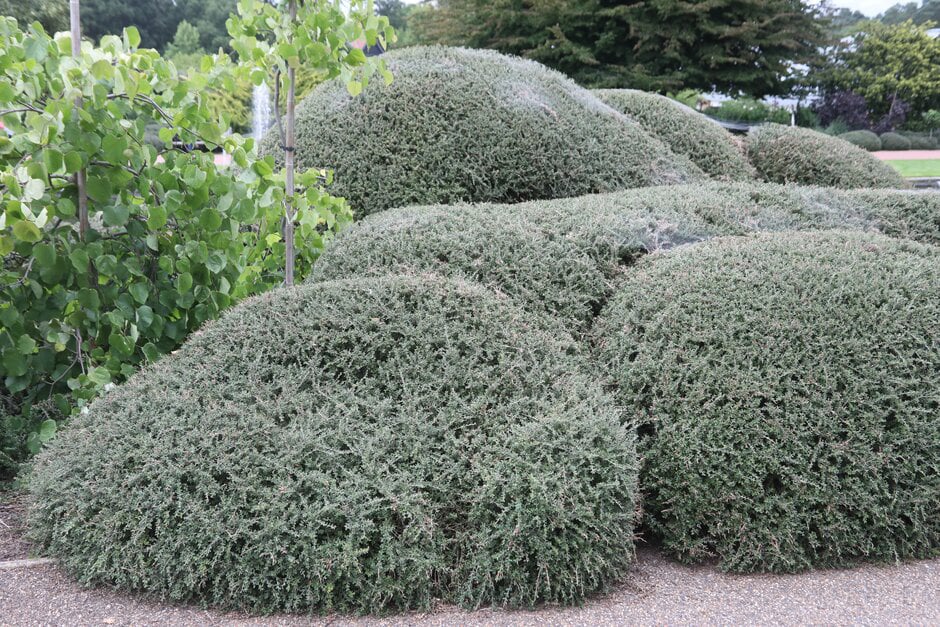Box blight: keeping it out
If you do not have box blight in your garden, or are yet to plant box, then there are steps you can take to minimise the risk of it arriving and at the same time prepare the garden for its possible arrival.
Quick facts
Quarantining box plants and cleaning tools helps keep box blight out of your garden
Finding box blight early makes it easier to manage
Spacing plants wider apart reduces the risk of box blight spreading
A small number of box cultivars are less susceptible to the disease
Jump to
Designing a garden to reduce box blight impact
Box blight may never appear in your garden. However, in case it does, there are a few simple planting considerations that will make it easier to isolate and manage.
Nothing is quite like box (Buxus spp.). No matter whether you have a few balls or topiaries, a parterre or two, or a garden based on it, box adds a structure than no other plants can quite match. With its naturally dense and rounded growth habit, box can be used in many ways and can find a place in any garden.
Of course, the delights of box go out the window if an outbreak of box blight results in unsightly bare patches. Box blight can be difficult to manage once it is found in a garden and forward planning should start with elements of garden design. Whether designing a garden from scratch, or making changes here or there, it is important to consider whether to grow box, where and how to grow it and what cultivars to choose.
Decide how much box to plant
Only grow as much box as you can manage.
Choose less susceptible box cultivars where possible
Calonectria pseudonaviculata and C. henricotiae attack most Buxus species. Other plants in the Buxaceae family, such as Pachysandra terminalis and Sarcococca species, are somewhat susceptible.
- Buxus species and cultivars differ in susceptibility to box blight, although none are highly resistant
- Common box and the dwarf form B. sempervirens 'Suffruticosa' (popular for parterres) are very susceptible
- In general the cultivars of B. microphylla are less susceptible than cultivars of B. sempervirens
- Based on work done in Belgium, cultivars 'Babylon Beauty', ‘Faulkner’, 'Heritage', 'John Baldwin', 'Belvédère', 'Rococo', 'National', 'Renaissance', 'Skylight' and 'Trompenburg' are less susceptible to the disease. Not all of these cultivars are widely available in the UK yet.
Consider alternatives to box in situations that favour box blight
There are many alternatives to box which could be considered in high risk situations, including where infected plants have been removed.
To be completely safe, or if you already have box blight that has become impractical to manage, choose an alternative hedge or topiary plant. Read our guide to choosing box alternatives, and then browse our box alternatives selection page to find a plant that works for you.

Guide to choosing box alternatives

Read the guide? Choose your box alternative
Create spaces between box plantings
- Avoid a continuous ‘pathway’ (e.g. a very long hedge) of box that the pathogen may move along
- Separation of box plantings with, for example, stretches of lawn or other plantings makes it easier to manage them as separate blocks
- Avoid surrounding box topiaries with box hedges
Plant box in well ventilated areas
Box blight thrives in shady, damp areas so avoiding these conditions will reduce risk.
- Choose areas that have good airflow so that leaves are unlikely to remain wet for long periods
- Create and maintain space around the box. Crowding out the box with surrounding plantings will reduce airflow and increase humidity. Watch out for rapid growth of
perennials - Spacing plants a little further apart than the traditional recommendations of 30-40cm (1ft-16in) for B. sempervirens and 10-15cm (4-6in) for the more compact B. ‘Suffruticosa’ will improve air circulation
- Avoid planting in areas with overhead watering. Drip irrigation will result in less leaf wetness
Minimise contact with box plants
- Minimising human contact will reduce the risk of arrival or spread
- Place topiaries and balls where they are not easily brushed past or handled especially in areas with frequent visitors
- Where box hedges will line paths, increasing the width of the path reduces the amount of physical contact and increases airflow
Keeping box blight out
Box blight is likely to be introduced into a garden via planting material, garden tools, footwear or clothing. It is possible that birds may introduce the pathogen on their feet but, as this is probably rare, it is best to focus on what you can do.
Introducing plants to the garden (quarantine)
- Hold any commercially sourced plants in isolation for at least four weeks to confirm they are free of infection before planting out. Commercial nurseries may use fungicides which suppress but do not kill the fungus and this isolation technique will allow time for suppressed disease to become visible
- Taking cuttings from healthy box in your garden will reduce the risk of introducing the disease
Good garden hygiene (sanitation)
- By the time you detect box blight in your garden, it is likely to have been there for some time. It is therefore good practice to clean pruning tools with a garden disinfectant or mild bleach solution between areas of the garden to minimise the risk of unwittingly spreading the disease
- If your equipment is shared between gardens (for instance if you employ a gardener), then you should take special care to ensure that tools and shoes are sanitised between gardens
Finding box blight early
The sooner you detect box blight in your garden, the greater your chances of managing it effectively.
- Check over box plants regularly for signs of ill health, pests or disease
- Inspect plants for early symptoms as Calonectria spreads very rapidly in warm and humid conditions (see our box blight page for more details on symptoms)
- Be aware of areas where box blight has occurred before as this is where it is most likely to recur
Managing the environment
If box blight does arrive, it is less likely to take hold and will be easier to manage if the garden environment is unfavourable for the disease. Here are some tips on creating such an environment. Adopt those that suit your particular garden and gardening style.
Already have box blight in your garden? See our page on box blight: managing outbreaks.
Manage the garden in discrete blocks
Managing box in discrete blocks where possible will help to isolate outbreaks if they occur by providing a physical gap between infected and uninfected areas.
Minimise the humidity associated with watering/irrigation
- Calonectria thrives in humid conditions
- Water in the morning where possible (this gives a shorter period of high humidity than evening watering)
- Avoid overhead watering if possible
Do not over- or under-fertilise
- Nutritional status can influence the resilience of plants against disease. Apply sufficient fertiliser to ensure healthy growth
- Fertilisers can also influence plant structure and leafiness. Use balanced fertilisers or those with higher potassium levels rather than high nitrogen levels
Use mulch under plants
- Mulch under plants to help cover pockets of disease (inoculum) and to reduce rain splash spreading box blight spores to the leaves. A soft mulch, such as ‘Topbuxus Carpet’ will reduce rain splash more than, for instance, a hard bark mulch
- Consider replacing old mulch with fresh occasionally, to remove any build up of disease below box plants
Remove leaf and other debris
- After trimming remove clippings from the surface of box plants or hedges and from within the centre of the canopy (some gardeners use vacuum cleaners to suck out the infected leaf debris which tends to lodge in the centre of the plant). Also rake up leaf litter from the base
- Removing leaf litter is a useful precautionary measure even if box blight has not been found in the garden
- Although it is good practise to compost healthy plant material, box blight is hard to detect at the early stages of infection so gardeners wanting to be extra cautious may wish to bin this instead. Material suspected of being infected should be bagged to avoid dropping debris around the garden
Create a plant with as open a structure as possible
Leaf and stem wetness favours infection and spore formation. The more open the plant structure is, the better the ventilation will be and the shorter the time the canopy will remain wet. Ways to achieve this include:
- Thin out branches to improve air-circulation
- Choose more open cultivars if this does not interfere with the desired plant appearance
- A 30-40cm (1ft-16in) spacing is traditionally recommended for common box and 10-15cm (4-6in) for ‘Suffruticosa’ and B. microphylla. Spacing plants a little further apart will improve air circulation
- Trim less frequently (frequent trimming leads to dense foliage and less air movement)
- Maximise the distance between the lowest leaves and the soil. The greater the distance spores need to splash from ground-based inoculum, the fewer spores that will reach leaves
- Prune a hedge with a convex top rather than flat. It has been suggested that a convex (rounded) top leads to better water runoff from a hedge than a traditional flat top. At the RHS, we are investigating whether this will reduce the severity of box blight
Minimise risk during pruning/trimming
- Prune in dry conditions, ideally between late May and the end of August (summer pruning will minimise the likelihood of prolonged leaf wetness)
- Do not use pruning equipment that has been used in other gardens. If being pruned by a contractor, ensure that equipment is clean (even better, have dedicated equipment for the garden)
- Monitor for box blight before pruning and deal with infected areas separately
- Begin work in areas least likely to be infected. Prune areas where infection has been seen previously after ‘clean’ areas
- Clean and disinfect pruning equipment between areas/blocks or have dedicated equipment for the most valued plantings
- Consider preventative fungicides during pruning. In a garden where box blight has already been seen or where extra measures are considered appropriate (e.g. important box plantings), fungicides could be applied 7 to 10 days before trimming and 7 to 10 days after trimming
Get involved
The Royal Horticultural Society is the UK’s leading gardening charity. We aim to enrich everyone’s life through plants, and make the UK a greener and more beautiful place.